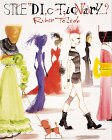Those who think of a dictionary as a collection of words defined by short articles and, perhaps, illustrated with some small, exacting pictures will be surprised by this book. Those who expect a reference book to give them concise definitions that leave no doubts (and yet plenty of doubts) about the nature of the thing defined will probably not consider this a useful addition to their "knowledge base". Such people who shiver when they see skyscrapers turn into women, vegetables transmogrifying into models, or wooden mannequins wearing bras made of skin will shun this book. Dull people who just see these combinations as weird, uninformative, and not the least bit funny probably best not crack the covers.
Labeling this work as a "dictionary" might seem misleading and heretical to some.  The odd pictures that borrow from the traditions of Bosche and the Surrealists don't define in the style to which we have become accustomed. The book is only half a dictionary, or rather half an abecenary and half a collection of drawings by the artist. It's filled with a lot of "silly things" that don't allow us to do with a dictionary what we think a dictionary should be used for. Nothing here is neat and measured out. Lots of things are ambiguous and downright bizarre. If you look to put things into orderly words, you will feel lost and, perhaps, that you have wasted your money. I know I am attempting to describe this thing you have never seen before by saying which of the usuals it is not. It's like describing a gharial by saying it is not a crocodile or an alligator, not a snake, not a lizard, a fish, a toad, a mammal, or other kind. I can say "crocodile and alligator" come closest to describing what a gharial is and, when you first look at it, you will be struck by the similarities, but there are things about gharials that do not match either of these creatures. And likewise, "dictionary" comes closer than a lot of terms in describing what Toledo has done here. But it is not really a dictionary. Not in the usual sense. Toledo doesn't show just show the things and name them. He plays with them and it is in his play that you start to learn something about fashion. As Richard Martin says in the introduction "Toledo is the artist who gives us the vocabulary and unforgettable images that meld fashion at its most ephermeral and impressionable with style at its most abiding."
The odd pictures that borrow from the traditions of Bosche and the Surrealists don't define in the style to which we have become accustomed. The book is only half a dictionary, or rather half an abecenary and half a collection of drawings by the artist. It's filled with a lot of "silly things" that don't allow us to do with a dictionary what we think a dictionary should be used for. Nothing here is neat and measured out. Lots of things are ambiguous and downright bizarre. If you look to put things into orderly words, you will feel lost and, perhaps, that you have wasted your money. I know I am attempting to describe this thing you have never seen before by saying which of the usuals it is not. It's like describing a gharial by saying it is not a crocodile or an alligator, not a snake, not a lizard, a fish, a toad, a mammal, or other kind. I can say "crocodile and alligator" come closest to describing what a gharial is and, when you first look at it, you will be struck by the similarities, but there are things about gharials that do not match either of these creatures. And likewise, "dictionary" comes closer than a lot of terms in describing what Toledo has done here. But it is not really a dictionary. Not in the usual sense. Toledo doesn't show just show the things and name them. He plays with them and it is in his play that you start to learn something about fashion. As Richard Martin says in the introduction "Toledo is the artist who gives us the vocabulary and unforgettable images that meld fashion at its most ephermeral and impressionable with style at its most abiding."
To recapitulate: lexicographical despots will despise this book because it is not neatly laid out in pigeon holes and includes a long, psychotic second half arranged in no decent order by the standards of dictionary writers. Hunters of tropes like myself will love this book. It shows more than just the things named by such words as merkin, drag queen, S-curve, high heels, bikini, and dress: it grants insight into the creative minds that are constantly trying to create the stuff that we consumers will buy. It dares to comment on trends in the tastes of designers in the language that is not a language that designers use themselves to create the things they drape over anorexic models. This is a book that will entertain many and ennervate the poets to make new associations, new visions, new meanings.
Posted by EmperorNorton at July 29, 2002 11:15 PM | TrackBack